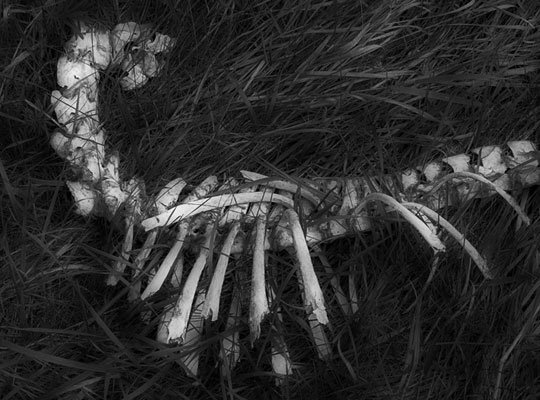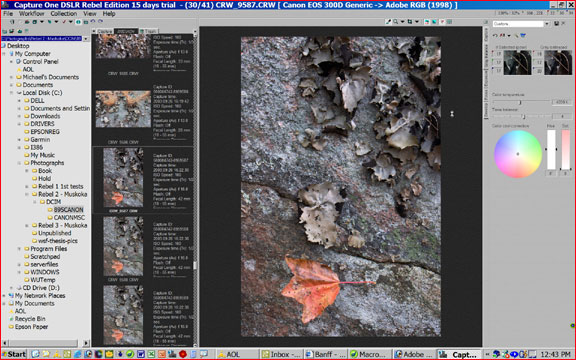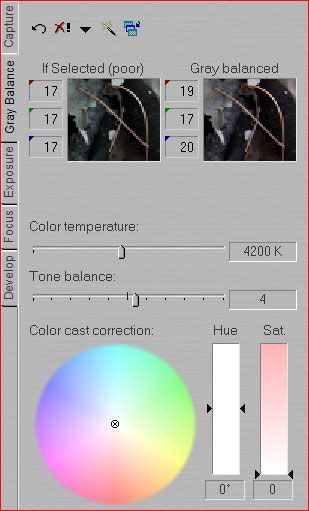"Rebel"
noun : 14th century
— one who rebels or participates in a rebellion —
Rebel With A Cause
TheCanon EOS Digital Rebelis Canon’s latest marketing step toward domination of the digital camera market. Last year the president of Canon, in an interview in a Japanese magazine, made a very unambiguous statement — and I paraphrase — that it was Canon’s intention to become the 800 pound gorilla of the unfolding digital photography marketplace. With the worldwide shipment of theRebel / 300D / Kiss Digital(nomenclature depending on where in the world that you reside) in mid-September, 2003 the company has shown that it meant what was said. With the1DsCanon clearly dominates the DSLR high ground; the1Dis strongly positioned among photojournalists and sports photographers; the10Dis a segment leader in the 6 Megapixel mid-range, and now theRebelwill likely score big in the trenches, otherwise known as the entry DSLR marketplace.
With a retail price of under U.S. $1,000 (with18-55mm EF-S lens), and $899 for body only, Canon has in a single stroke changed the name of the game. For the same price — less than that of many digicams, consumers can now purchase a real 6 Megapixel DSLR.
Rather than provide a bells and whistles review, which sites likeDPReviewdo with mind-numbing detail, it’s my intention here to see how well theRebelaccomplishes its goals, both from the consumer’s as well as Canon’s perspectives. Of course I will be comparing theRebelto Canon’s10D, which from an image quality perspective is almost identical, yet which costs nearly twice as much.

Maple Leaf. Hardy Lake Provincial Park, Ontario — September, 2003
Canon 300D Rebel withEF-S 18-55mm f/3.5-5.6 lens @ ISO 100
_______________________________________________________
Making a Price Point
Four years ago a 6 Megapixel DSLR cost $30,000. A little less than eighteen months ago the price had dropped to under $3,000, and today — with theRebel— it’s now well under $1,000.Moore’s Lawin action. But while photographers rejoice, what does this portend for other manufacturers? And, what does the consumer get for his or her money?
Below is a table (listed alphabetically) showing typical online prices for the available 6MP cameras in the U.S. as of late September, 2003. (I’ve included the Sigma even though strictly speaking it isn’t a 6MP camera, because it produces comparable results and is aggressively priced, and also the Olympus E-1 is included for completeness, even though it’s a 5MP camera and not yet shipping.)
Not much more needs to be said on this subject. Canon’sRebelcosts anywhere from 30% — 45% less than other 6MP cameras, and when you consider it equipped with its kitted18-55mm EF-Szoom lens, the differential is even greater.
This is going to put tremendous pricing pressure on the other manufacturers, especially during the Xmas 2003 season. Is this fair? In a way not, because theRebelis much less expensively built than its competitors. But, it alsoisfair, because the image quality produced by theRebelis every bit as good as that from any of the other 6MP cameras listed.
One doesn’t get "something for nothing", as the saying goes, and theRebeldoesn’t change this paradigm. Compromises have been made to bring the price down, and below we’ll see what these are and also discover if they really make a difference to photographers.
As for the other manufacturers, their problem lies in several areas. Firstly, I don’t think that they expected Canon (or anyone for the matter) to become this aggressive on pricing this quickly. For this reason, it may well take them a while to tool up for competitive models. Secondly, Canon has a distinct advantage as a consequence of producing their own imaging and processing chips. OnlyFujiamong the other manufacturers listed does so. All of the others source their imaging chips from companies such asSonyandKodak. This obviously puts them at a price disadvantage.
Not to be overlooked as well is Canon’s newDigicchip, which was first introduced earlier this year in the10D,S50andG5. This is a dense, highly integrated image processing and peripheral process chip of Canon’s own design and manufacture. It replaces a considerable number of other chips and circuits, and consequently provides Canon with large cost savings. Neither of these advantages are going to be easy for the other manufacturers to overcome in the near term.
It should be noted as well that theRebelis manufactured in Taiwan, rather than Japan. This obviously helps reduce manufacturing costs as well.

Bones and Grass. Ontario — September, 2003
Canon 300D Rebel withEF-S 18-55mm f/3.5-5.6 lens @ ISO 100
The making of this photograph is detailed in
Miscellaneous Momentsfor September, 2003
_______________________________________________________
Where’s The Beef?
Right — we know that it’s a lot less expensive that other cameras. We also know that Canon has the advantages mentioned above. But how does this translate into flesh and blood (or at least plastic) reality? Not at all badly, actually.
Knowing beforehand that theRebel’sbody was plastic, rather than cast magnesium — as is the10D,or aluminium, as are many others —I was prepared for a camera body that was both light weight and a bit flimsy. The light weight we got, but flimsy it isn’t. In fact in some ways it feels even more rigid than the predecessorD60. That camera wouldgivea bit if squeezed hard. TheRebeldoesn’t — at all. I also expected the body to feel "plasticy". It doesn’t, and the combination of light weight, rigidity and silver colour almost makes one think that the body could be made from some light weight metal alloy.
Now don’t misinterpret this. The body is clearly plastic, and just a few moments examining it makes this obvious. And, the fit and finish is nowhere near that of cameras costing almost twice as much. But, even on an absolute scale it really is quite acceptable.
I was also prepared to dislike the silver (actually pewter-coloured) finish. While it isn’t what the discerning pro seeking discreetness might want, for a consumer camera it appears quite elegant, and I’m sure that many will find it attractive. The grip area is covered in a rubber textured material to prevents it from being slippery, especially when hands are wet with perspiration, and this area’s black finish tends to break up the silver of the rest of the body. Not at all unattractive.
_______________________________________________________
In Hand
The Rebel is from the current Canon idiom when it comes to control layout, but with one major difference. There is no second control dial on the camera’s rear panel. This has necessitated some interface changes — none of them terribly dramatic though. In fact I used the camera for a couple of days before I even bothered to read the manual. Anyone who has used one of Canon’s DSLRs will become comfortable with theRebelvery quickly, and while users of Canon film bodies will take somewhat longer, the non-digital aspects of the control layout are quite traditional.
Buttons — We’ve Got Buttons
To someone new to the Canon brand, and especially someone new to digital cameras, the number of buttons and controls will at first be somewhat daunting. That, unfortunately, is the nature of the beast. I counted 22 buttons, wheels and knobs, and then there are also the literally dozens of menu choices available on the colour LCD display. More on this in a while.
Controls
There are far too many controls to be discussed in detail here. Again,DPReview’sexhaustive description of every button’s features and functions will tell you what you need to know in this regard.
Weight
I mentioned how light theRebelis. In fact it weighs just 645g / 22.8oz. This compares to the more typicalCanon 10Dat 835g / 30.9oz. Only the newPentax *ist Dis as light weight, weighing in almost identically to theRebel.
Battery
In terms ofbattery capability theRebelleaves little to be desired. It uses the sameBP-511rechargeable Lithium Ion battery as did theD30,D60and10D. This should provide enough juice for hundreds of frames, and since these are available inexpensively from third parties as well as from Canon having an extra battery or two will mean few vacationers will need to even bring along the charger.
Flash
There is, of course, a built-in flash. It pops up automatically when needed in beginner’s modes, or manually when desired in the standard shooting modes. When elevated it is noticeably higher above the lens the one on the 10D, for example, and this should mean less red-eye problems when doing snapshots. There is of course a hot shoe, and all Canon external flash units are accepted. Full functionality is only available with EX models though. There is no PC socket for external flash units.
Viewfinder
I was surprised at the viewfinder image. TheRebeldoes not use a pentaprism the way most SLRs do. Instead it has what Canon calls apentamirror. This consists of a series of mirrors the reflects the light from the main flip-up mirror to the eyepiece. This has been used in the past by other manufacturers to achieve a lower price and lighter weight, and it usually leads to a dimmer viewfinder. But, in the case of theRebelI can’t see much difference between it and theCanon 10D. Of course both viewfinders are smaller and darker than on a Canon film body, or the full-frame 1Ds, because of the reduced field of view caused by the 1.6X reduction factor of the APS sized imaging chip.
As has been noted by other reviewers theRebel‘s mirror seems to cause a bit more noise and slap than with other models, a sign that there have been some cost savings in the area of mirror damping. There is also no mirror lock-up capability on theRebel, which combined with the somewhat greater mirror slap noted will make a difference for some critical photographers. (Parenthetically, I noted quite a few blurred images with long exposures, even with the camera tripod mounted. The mirror does cause a lot of slap and the low mass of the body fails to provide much damping).
For those reading this who have never used a aSingle Lens Reflex(SLR) before, be aware that there is no image preview as there is with digicams. What you see though the viewfinder is what will be seen by the imaging chip, directly though the lens and with no electronics or pixels to get in the way. When you press the shutter release the instant return mirror flips up, blocking the viewfinder for a moment and allowing the chip to see what you’ve been seeing. An instant later the mirror returns and the viewfinder once again shows you what the camera is seeing.
The LCD
On the rear of the camera there is the usual colour LCD screen. It is used to both review images taken as well as to make camera settings. It is clear and bright, better in fact than the LCD on the 10X more expensiveCanon 1Ds. The camera can be set to display a review image (optionally with histogram) automatically a couple of seconds after taking a shot. This, especially when displayed with histogram, is invaluable for judging exposure. If you’re new to histograms, have a look at my article onUnderstanding Histograms, which explains what their use and advantages are.
While the histogram can be optionally displayed on post-exposure review, when images are reviewed separately afterwards, unlike on other Canon models the camera can not be set to automatically show histograms and other shooting data along with the image. This can be accomplished manually though by pressing theInfobutton while a review image is displayed.
The Mono LCD
All previous Canon DSLRs have a monochrome top-plate LCD for displaying various camera setting information, such as frame number, ISO setting,White Balance, exposure compensation and the like. Because of its reduced size, on theRebelthis display has been moved to a position just above the rear panel colour LCD. My concern with this positioning is that when the camera is hanging on a strap around ones neck, or on a tripod below eye level, none of this vital information is readily visible. A minor point to be sure, but it became an annoyance on a number of occasions when working with the camera.
Card Slot
TheRebeltakesCompactFlashcards, including Type IIMicrodrives. It also isFAT 32enabled which means that it can take newer cards that store more than 2 Gigabytes. With 6 GB cards coming in 2004, and the price of high capacity cards continuing to drop, this is a worthwhile feature.
The Kitchen Sink
I could go on with this for several more pages, but we’d both get bored. So here instead are a few of what I regard as the more relevant features for the serious photographer…
— shooting speed; 2.5 frames per second for up to 4 frames
— ISO range; ISO 100 to 1600
— shutter speeds; 30 seconds to 1/4000 sec
— Autofocus; 7 points with illuminated selected point and manual point selection capability
— Metering; 35 point, partial 9 degree and center weighted, depending on shooting mode. Not user selectable.
— Color Modes; sRGB and Adobe RGB
Drift Needles. Ontario — September, 2003Canon 300D Rebel withEF-S 18-55mm f/3.5-5.6 lens @ ISO 100
_______________________________________________________
What’s Missing? Image Quality?
Surprisingly little is missing, given that Canon has had to be careful not to cannibalize sales from its next up the model-ladder brother, the almost twice as expensive10D. Of course image quality is of primary concern, and I’ll cut to the chase. When using the same lenses image quality is essentially identical to that from theCanon 10D. Both cameras use virtually the identical imaging chip and processing electronics, so this isn’t surprising.
That makes image quality about as good as it gets from the current state-of-the-art. Few would argue that Canon’s CMOS technology produces some of the cleanest images around, with excellent resolution and accurate colour. I don’t know of any 6MP camera available today that can exceed this all-around performance in any meaningful way.
But, there are indeed a few things missing. It would be surprising if there weren’t, given the price point. I have mentioned a few of them already — no mirror lock up; no user selectable metering modes; and also slightly reduced high ISO capability (no ISO 3200) along with somewhat slower shooting speed and a mirror mechanism with more vibration and slap.
I don’t see any of these as deal breakers, considering this camera’s primary constitituancy. There has been some online bitching about the lack of user selectable metering modes, but I’m not impressed by any of the arguments to date. Frankly, digital shooting isn’t the same as shooting film. If this was a film camera I would be more concerned, but with digital, for me at least, the histogram is my primary metering tool. Combine that with Canon’s very effective 35 point metering and I for one am not at all bothered by this.
There are a few other niggles. The camera strap is a nasty rubberized fabric, and the rubber eye cup on the viewfinder is made of such soft rubber that it acts as a lint magnet. Leave your Angora sweater at home.
_______________________________________________________
Software
Canon provides both PC and Mac users with a comprehensive selection of image processing and viewing software. These are pretty much the same programs that we have seen with most Canon digital cameras over the past couple of years. Also included is a copy ofPhotoshop Elements, a $99 value and a good place for newcomers to image processing to start. But…
As good as Canon’s camera’s, lenses and digital technology generally are (and regular readers know that I’m a long time Canon user), Canon’s RAW conversion software continues to be dreadful. It’s created by the same mentality as designedKodak’s DCS Photodeskapplication, another RAW converter that has no regard for the user’s time.
What’s this all about? It has to do with RAW files. If you’re new to this let me explain. Digital camera’s generally can produce both JPG files and RAW files. JPG files are by definition compressed, andlossy. Lossy means that every time the file is saved or resaved it looses information. Also, a JPG file from a camera has been pre-processed. Parameters like White Balance, colour balance and sharpening have all been applied. If you shoot JPGs this means that you have to set the camera’s White Balance when shooting or let the camera select it in "Auto" mode. You’re then stuck with whatever the camera set.
If you let the camera shoot RAW, the file you end up with is exactly what the imaging chip recorded, with no in-camera processing. RAW means raw. Everything from linear conversion, Bayer interpolation, White Balance, colour balance and more is done afterward on your computer using RAW conversion software. Also, though the files are compressed they are losslessly compressed, and therefore no information is lost when the files are saved and reloaded.
Why not work exclusively in RAW you say? Because it takes extra time and work. You have to make decisions and need to adjust the files to the way that you want them to look. Some users prefer to be able to simply shoot and print. If that’s you, fine, shoot JPGs and enjoy. But serious photographers will want to work in RAW mode and that’s where Canon lets its users down.
The strength of digital image processing is that it’s WSIWYG —What you see is what you get. If your monitor is properly profiled and calibrated, and so is your printer, (much more on this is found elsewhere on this site), then what you see on the screen should be essentially identical to what comes out of your printer. When working inPhotoshop, for example, if you change an image’s colours, brightness or contrast the changes happen instantly. Get it too look the way you want it to on-screen andBob’s your Uncle.
But with Canon’s RAW conversion software the smallest change that you make to any of the required settings means that the computer has to recalculate the entire image to show you what it will look like. This means that making the critical image adjustments needed to prepare an image for RAW conversion can take far longer than it should. For the hobbyist with just a few files to process and with time to burn, no big deal — maybe. But for someone with a lot of images to process, or anyone trying to do exacting work, this can be exasperating to say the least.
Is there a solution? Yes, there is, but it isn’t available from Canon.
Capture One Rebel
Capture One Rebel showing file browser, thumbnails, interactive preview and palettes selectorIn my opinion the best RAW image processing software available for any camera isPhase One’s Capture One.Phase Oneis a hardware and software company with years of digital image processing experience because they are the manufacturer of some of the industry’s most advanced (and expensive) medium format digital camera backs.
When Canon introduced its industry leading1Dsin the Fall of 2002Phase OneintroducedCapture One DSLR, a version of their image processing software that for the first time supported a camera or digital back other than their own. I tested it early on and was knocked out by its speed, features and functionality. It now supports not only the1Dsbut also theCanon 1D, 10D, D60, D30, andNikon D1x, D100, and will soon support theCanon 300DandFuji S2. TheMacversion supports theCanon 1Dsand1D,with10D,300DandD1xsupport on the way.
The only concern that I had was that the price was $499. Even so, I consider it a must have for anyone using one or more of these cameras, and its popularity with professional photographers has shown that others agree with my assessment.
In early 2003Phase OneintroducedCapture One LE,a version that supports theCanon D30, D60,10DandNikon D100, with300Dsupport coming soon. At $99 its price is more appropriate for owners of these cameras.
Now, with Canon’s introduction of the300D Rebelwe haveCapture One Rebel—Phase One’sversion of their famous software designed specifically to support theRebel(and only theRebel). In keeping with the aggressive pricing of the camera itself this software will have an introductory price of just $49. I have been working with a Beta version of this software and can tell you that it has essentially all of the functionality of its more expensive predecessors.
What is it that setsCapture One(C1) apart, and why should every Rebel owner download a test copy for evaluation? The answer lies in the concept ofworkflow. This is common digital image processing jargon that simply means the steps that we take when working with an image and the order in which we make them.
WithC1the efficient workflow begins with pointing the program to a directory containing someRebel RAWfiles. The first thing that one sees is that a window with thumbnails appears almost instantly. Once these have loaded the program spends a few seconds per image processing them so that you can work efficiently. This all takes place in the background, and you can choose any thumbnail and click on it to start work right away.
Capture One Rebel Gray Balance PaletteYou are then presented with a large detailed image that you can enlarge to 100% magnification instantly. You can also apply a full range of image processing controls and also instantly see what these changes will accomplish. When you’re done you can process this image or a group of images and immediately turn your attention to adjusting others while the program does the RAW conversion in the background. If you like you can also work in batch mode on a number of images that require the same or even different processing parameters.
C1 Rebelwill become available in late October and when it does I will have a more complete review and complete workflow suggestions.
(For those who are interested — what Capture One does, invisibly to you, is produce a high-res work file that’s small enough to work on instantly, yet big enough to show you everything you need to know. When you apply a change to the image the program doesn’t need to process a huge file, just the work file. When you are finished and want to move the file to Photoshop for further processing Capture One takes the charges that you made and applies them to the large file. What Canon’s RAW processing software does is to apply charges to the full file every time, making it slow and inefficient.)
Other Image Processing Options
There is currently a plug-in forPhotoshopcalledCamera RAW. It does a very fine job with most digital camera files, but does not currently support theDigital Rebel. The next generation of Photoshop (not Elements) will haveCamera RAWcapability built in and it’s fair to assume that support for theRebelwill be included.
One of the long time RAW conversion programs for Canon cameras,Breezebrowser, already supports theRebel. It is priced at $45.
While I’m on my soapbox, here’s a word of unsolicited advise for Canon. Photographers have been telling you for years that your RAW conversion software is below par. Yet, you persist on having your customers go to other vendors to have their RAW processing software needs properly met. It’s time that your programers in Japan recognize that they simply are not producing world-class software. With products likeCapture OneandCamera RAWwe see how it should be done. Either match their capabilities (and preferably exceed them) or acquire a product that can do a proper job. Canon camera purchasers shouldn’t have to buy extra cost third-party solutions to be able to work efficiently with your cameras.
_______________________________________________________
The Lens
The Digital Rebel is sold two ways — as body only for $899 and also as a kit with lens for $999. The lens included is anEF-S 18-55mm f/3.5-5.6zoom. Several opening comments. This lens is very small and very light. The reason for this is that it is very slow and very plasticy. Even the lens mount is plastic. (The Rebel body’s lens mount though is metal, unlike with some inexpensive film bodies. Kudos to Canon).
Given that the lens is only $100 when bought as part of the kit, none of this matters much. Newcomer to photography, digital or both will be just tickled by the package. Is the lens equivalent in image quality to one of Canon’s L series zooms that costs twice as much as the totalRebelcamera / lens kit? No. Of course not. But it’s a great buy for beginners. Undoubtedly newcomers will buy the kit while photographers who already have existing Canon lens systems will likely opt to buy just theRebelbody.
It must be noted that this lens is not a standardCanon EFlens. The "S" designation means that it provides reduced coverage, being designed for the reduced size (compared to full-frame 35mm) imaging chip found in theRebel. This is accomplished by a slight redesign of the Canon EF mount on theRebel, which still allows regular EF lenses to me attached but which prevents this EF-S lens from attaching to any other Canon camera.
What is the purpose of this? Simply to reduce costs by reducing the size of the optics. A penny here, and penny there, and pretty soon you have a 6 MP camera with zoom lens for under $1,000.
I note that the lens does not ship with a lens shade. This is a shame. Not so much because purchasers will have to spend additional money to buy a specialized shade for this lens (which is what I’d do), but that newcomers may not even realize that a decent lens shade is one of the best investments in image quality that one can make.
Of course everyone wants to know what the image quality is like. In three words —not that great. After a few hundred frames it’s obvious to me that the lens is the weakest part of the package. The fact that it’s inexpensively made is obvious. But regrettably its performance doesn’t rise above its construction quality. Besides being very slow, it simply isn’t as sharp as one could wish. I don’t believe that it’s much worse than most other inexpensive consumer-grade zoom lenses, but on a camera with such a high resolution sensor its failings quickly become obvious — especially when compared with lenses costing just 3X as much, let alone 15X as much, which is what Canon’s best glass costs. (In fairness, I just may have had a soft sample — you should do your own tests and comparisons if you get one.)
Are you surprised? No, probably not, and you shouldn’t be, because theRebelis an anomalous camera. By this I mean that its build and material quality (so – so), its features (reasonably complete) and its digital image quality (superb) just don’t all belong in the same camera. As I said — anomalous.
A final critique of theEF-S 18-55mm f/3.5-5.6zoom is that the front element rotates as the lens is focused. This means that if a polarizing filter is attached and adjusted, but then the subject distance changes, as the lens refocuses the polarization angle will be changed as well. Since then manually rotating the filter to correct this also runs the risk of defocusing the lens, the entire design is fraught with potential problems for anyone using a polarizer. And, since a polarizer is the most useful filter for photographers, it’s clear that this is not one of the lens’ strong points.
_______________________________________________________
Should you Buy A Rebel?
The answer very much depends on your photographic needs and experience. Here’s what I would suggest…
> if you are new to photography, have a restricted budget, and this is your first serious camera… go for it. Get theRebelkit with lens. It’s likely the best camera investment that a beginner can make today, and you’ll probably become a better photographer with it than you might with a comparably priced digicam.
> if you are a somewhat experienced film-based photographer on a tight budget, and now’s the time for you to move up to digital, theRebelis a great choice. Just save your pennies and buy a more capable lens at the same time. You’ll quickly outgrow theEF-S 18-55mm f/3.5-5.6, and worse yet, when you decide to upgrade to another camera down the road this "S" series lens likely won’t fit it.
> if you already own a Canon digital camera and need a second or backup body, or one for light-weight hiking or vacation use, this is the ticket. Just skip the kit and avoid the lens.
> If money isn’t that tight and you’re looking for a quality 6MP DSLR, then I’d suggest instead theCanon 10Dif you are looking within the Canon line. This gives you a more robust body, additional important features like mirror lock-up and metering mode selection among other improvements.
But, whether you buy aCanon Rebel 300Dor not, it’s worth knowing that we have just witnessed a price / performance breakthrough in the digital camera wars, and the ultimate winners are us.
_______________________________________________________
Coming Soon
Issue #9ofThe Video Journal, due for release in December, 2003, will feature a comprehensive field review of theDigital Rebelincluding footage from my fall Rockies shoot.
_______________________________________________________
Two Must Haves
If you have bought, or are contemplating buying aDigital Rebelyou’ll be pleased to learn thatPhase Oneis now making their superbCapture Onesoftware available for just $29.95. This price is good until November 15th, at which time it becomes $49.95. This software isa mustfor anyone working with this new camera.
Uwe Steinmeullerhas just published a new edition of of his well-regardedDigital Outback E-Booklet. This one is specific to theDigital Rebel,Photoshop ElementsandCapture Onefor the Rebel. This is the fastest way for beginners to get up to speed on digital workflow. It sells for $17.95 and is well worth the price.
_______________________________________________________



